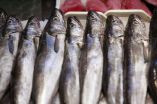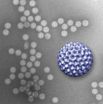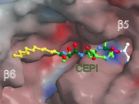(Press-News.org) A researcher at the Auburn University Museum of Natural History and Department of Biological Sciences has reported the discovery 33 new trapdoor spider species from the American Southwest. These newly described species all belong to the genus Aptostichus that now contains 40 species, two of which are already famous – Aptostichus stephencolberti and Aptostichus angelinajolieae.
The genus now includes other such notable species as Aptostichus barackobamai, named for Barack Obama, the 44th President of the United States, and reputed fan of Spiderman comics; Aptostichus edwardabbeyi, named for environmentalist and author Edward Abbey (1927-1989); Aptostichus bonoi from Joshua Tree National Park, named for the lead singer of the Irish rock band U2; Aptostichus pennjillettei named for illusionist and intellectual Penn Jillette; Aptostichus chavezi, named for Mexican American and civil rights and labor activist César Chávez (1927-1993).
Other notable new species names include Aptostichus anzaborrego, known only from the Anza Borrego Desert State Park in southern California; and Aptostichus sarlacc from the Mojave Desert, named for George Lucas' Star Wars creature, the Sarlacc from the fictional desert planet Tatooine.
The researcher, Prof. Jason Bond, who is a trapdoor spider expert and the director of the Auburn University Museum of Natural History was excited at the prospect of such a remarkable and large find of new species here in the United States and particularly California.
"California is known as what is characterized as a biodiversity hotspot. Although this designation is primarily based on plant diversity, the region is clearly very rich in its animal diversity as well. While it is absolutely remarkable that a large number of species from such a heavily populated area have gone unnoticed, it clearly speaks volumes to how little we know of the biodiversity around us and that many more species on the planet await discovery " Bond said.
Like other trapdoor spider species, individuals are rarely seen because they live their lives in below-ground burrows that are covered by trapdoors, made by the spider using mixtures of soil, sand, and/or plant material, and silk. The trapdoor serves to hide the spider when it forages for meals at the burrow entrance, usually at night.
Aptostichus species are found in an amazing number of Californian habitats to include coastal sand dunes, chaparral, desert, oak woodland forests, and at high altitudes in the alpine habitats of the Sierra Nevada mountain range.
Bond said, "this particular group of trapdoor spiders are among some of the most beautiful with which I have worked; species often have gorgeous tiger-striping on their abdomens. Aptostichus to my mind represents a true adaptive radiation – a classical situation in evolutionary biology where diversification, or speciation, has occurred such that a large number of species occupy a wide range of different habitats".
Bond also noted that while a number of the species have rather fanciful names, his favorite is the one named for his daughter Elisabeth. "Elisabeth's spider is from an incredibly extreme desert environment out near Barstow, California that is the site of a relatively young volcanic cinder cone. The spiders make their burrows among the lava tubes that extend out from the cone – it is a spectacular place to visit but the species is very difficult to collect because the spiders build rather deep burrow among the rocks".
INFORMATION:
Original source
Bond JE (2012) Phylogenetic treatment and taxonomic revision of the trapdoor spider genus Aptostichus Simon (Araneae, Mygalomorphae, Euctenizidae). ZooKeys 252: 1. doi: 10.3897/zookeys.252.3588
Additional information
Bond JE and AK Stockman. 2008. An Integrative Method for Delimiting Cohesion Species: Finding the Population-Species Interface in a Group of Californian Trapdoor Spiders with Extreme Genetic Divergence and Geographic Structuring. Systematic Biology, 57: 628-646, doi: 10.1080/10635150802302443
Posted by Pensoft Publishers.
33 new trapdoor spider species discovered in the American southwest
2012-12-20
ELSE PRESS RELEASES FROM THIS DATE:
Cellphone data helps pinpoint source of traffic tie-ups
2012-12-20
CAMBRIDGE, Mass. -- In most cities, traffic growth has outpaced road capacity, leading to increased congestion, particularly during the morning and evening commutes. In 2007, congestion on U.S. roads was responsible for 4.2 billion hours of additional travel time, as well as 2.8 billion gallons of fuel consumption and an accompanying increase in air pollution.
One way to prevent traffic tie-ups is to have fewer cars on the road by encouraging alternatives such as public transportation, carpooling, flex time and working from home. But a new study — by researchers at MIT, ...
Spanish consumers prefer national fish
2012-12-20
What is most important when buying fish: the price, the country of origin, whether it is fresh or frozen or whether it is wild or farm-raised? The average Spanish consumer prefers above all that their fish comes from Spain, according to a study published in the 'Food Quality and Preference' journal. Spain is the largest producer of fish in the European Union but in recent years its population has consumed less fish, especially seafood.
A team of scientists brought together nearly 900 consumers from nine Autonomous Communities (Andalusia, Asturias, the Balearic Islands, ...
MIT researchers discover a new kind of magnetism
2012-12-20
CAMBRIDGE, Mass. -- Following up on earlier theoretical predictions, MIT researchers have now demonstrated experimentally the existence of a fundamentally new kind of magnetic behavior, adding to the two previously known states of magnetism.
Ferromagnetism — the simple magnetism of a bar magnet or compass needle — has been known for centuries. In a second type of magnetism, antiferromagnetism, the magnetic fields of the ions within a metal or alloy cancel each other out. In both cases, the materials become magnetic only when cooled below a certain critical temperature. ...
A nanoscale window to the biological world
2012-12-20
If the key to winning battles is knowing both your enemy and yourself, then scientists are now well on their way toward becoming the Sun Tzus of medicine by taking a giant step toward a priceless advantage – the ability to see the soldiers in action on the battlefield.
Investigators at the Virginia Tech Carilion Research Institute have invented a way to directly image biological structures at their most fundamental level and in their natural habitats. The technique is a major advancement toward the ultimate goal of imaging biological processes in action at the atomic ...
Production of 5-aminovaleric and glutaric acid by metabolically engineered microorganism
2012-12-20
We use many different types of chemicals and plastics for the convenience of our everyday life. The current sources of these materials are provided from petrochemical industry, using fossil oil as a raw material. Due to our increased concerns on the environmental problems and fossil resource availability, there has been much interest in producing those chemicals and materials from renewable non-food biomass through biorefineries. For the development of biorefinery process, microorganisms have successfully been employed as the key biocatalysts to produce a wide range of ...
Game changing diagnostic & prognostic prostate cancer genetic tests revealed by Jefferson
2012-12-20
PHILADELPHIA—Researchers at the Kimmel Cancer Center at Jefferson (KCC) (insert link to "Kimmel Cancer Center at Jefferson" www.kimmelcancercenter.org) have developed potentially game-changing diagnostic and prognostic genetic tests shown to better predict prostate cancer survival outcomes and distinguish clinically-relevant cancers.
The team, led by Richard G. Pestell, M.D., Ph.D., Director of the KCC and the Chair of the Department of Cancer Biology at Thomas Jefferson University, report their preclinical findings from a blinded, retrospective analysis of over 350 ...
Can observations of a hardy weed help feed the world?
2012-12-20
As the human population increases, so too do the demands and stresses on agriculture. In the January 2013 issue of International Journal of Plant Sciences, Penn State University Waller Professor of Plant Biology Dr. Sarah Assmann explores how the responses to environmental stresses by one small, genetically diverse plant species might illuminate possible approaches to addressing growing human demand for crop products amid decreasing resources.
In the article, Dr. Assmann describes how human population growth presents new challenges to twenty-first-century agriculture, ...
Serendipity points to new potential target and therapy for melanoma
2012-12-20
A University of Colorado Cancer Center study in this month's edition of the Journal of Investigative Dermatology describes a new target and potential treatment for melanoma, the most dangerous form of skin cancer. MicroRNA can decide which genes in a cell's DNA are expressed and which stay silent. Melanoma tends to lack microRNA-26a, which makes the gene SODD go silent.
"It's a double negative," says Yiqun Shellman, PhD, investigator at the CU Cancer Center, associate professor at the CU School of Medicine, and the study's co-senior author. "miR-26a works to stop the ...
Cultural, social factors identified as barriers to minority participation in stem cell donation
2012-12-20
New research examining the role of race and ethnicity in an individual's decision to become a donor for hematopoietic cell transplantation (HCT) identifies several factors associated with varied participation rates in national donor registries across racial/ethnic groups. Results of this first-of-its-kind study are published online today in Blood, the Journal of the American Society of Hematology (ASH).
Hematopoietic cell transplants serve as valuable treatments for a range of blood disorders, as they generate new, healthy blood cells to replace diseased cells. While ...
Poison for cancer cells
2012-12-20
This press release is available in German.
In their quest for new agents, pharmaceutical researchers test millions of substances all over the world. They like using color-forming reactions to identify new molecules. However, in intensively colored solutions or in the case of mixtures with multiple substances these tests fail. As part of his doctoral thesis, Martin Stein, member of staff at the Chair of Biochemistry at the Technische Universitaet Muenchen, developed a testing reaction based on magnetic resonance data. It helps find a specific pharmaceutical molecule ...



